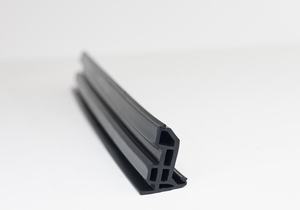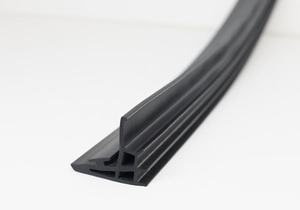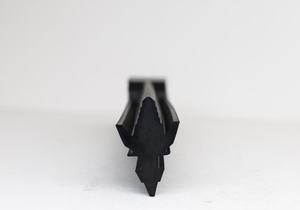Rubber gaskets are essential components used in various industries and applications, serving a crucial role in sealing and preventing the leakage of fluids, gases, or even contaminants. These versatile sealing elements are typically made from rubber or elastomeric materials due to their excellent sealing properties, flexibility, and durability.
Here’s a comprehensive description of rubber gaskets, covering their types, materials, applications, manufacturing processes, and importance:
Types of Rubber Gaskets:
- Solid Rubber Gaskets: These are one-piece gaskets typically made from materials like neoprene, EPDM (ethylene propylene diene monomer), silicone, or natural rubber. They provide reliable sealing against water, air, and other fluids and are commonly used in plumbing, automotive, and industrial applications.
- Sponge or Foam Rubber Gaskets: These gaskets have a porous structure and are designed to compress easily. They are ideal for irregular or uneven surfaces, providing a more forgiving sealing solution. Silicone sponge gaskets are used in electrical enclosures and HVAC systems.
- Rubber O-Rings: O-rings are circular rubber gaskets with a cross-sectional shape resembling the letter “O.” They are commonly used in hydraulic and pneumatic systems, as well as in various mechanical applications, to prevent leaks and ensure proper sealing between mating parts.
- Rubber Flange Gaskets: These gaskets are specifically designed to seal the joints between flanged pipes, valves, and fittings. They come in various shapes, including full-face gaskets and ring gaskets, to accommodate different flange designs.
- Custom Molded Rubber Gaskets: These gaskets are tailored to fit unique or complex geometries and are often used in specialized industrial equipment and machinery.
Materials Used in Rubber Gaskets:
Rubber gaskets can be crafted from a wide range of elastomeric materials, each with specific properties suitable for various applications:
- Nitrile rubber (NBR): Resistant to oil, fuel, and grease, making it suitable for automotive and industrial applications.
- Neoprene: Offers excellent weather resistance and is often used in outdoor applications.
- Silicone: Known for its high-temperature resistance and flexibility, making it suitable for food-grade, medical, and aerospace applications.
- EPDM: Possesses excellent resistance to weathering, ozone, and UV radiation, making it ideal for outdoor and automotive applications.
- Viton (fluoroelastomer): Known for its exceptional chemical resistance, often used in harsh chemical environments and the aerospace industry.
Applications of Rubber Gaskets:
Rubber gaskets find application across various industries and sectors, including:
- Automotive: Engine gaskets, transmission gaskets, and exhaust system gaskets to prevent fluid and gas leaks.
- Plumbing: Sealing joints in pipes, valves, and faucets to prevent water leaks.
- Industrial Machinery: Gaskets in heavy machinery and equipment to maintain hydraulic and pneumatic seals.
- Aerospace: Gaskets in aircraft engines and components to ensure air and fluid tightness.
- Electronics: Gaskets in electrical enclosures and electronic devices to protect against dust, moisture, and electromagnetic interference.
- Pharmaceutical and Food Processing: Gaskets in equipment to maintain sanitary conditions and prevent contamination.
- Oil and Gas: Gaskets in pipelines, valves, and pumps to prevent leaks of hazardous fluids.
Manufacturing Process:
The manufacturing of rubber gaskets involves several key steps:
- Material Selection: Choosing the appropriate elastomeric material based on the application’s requirements.
- Mixing and Compounding: Mixing the rubber compound with various additives to achieve the desired properties, such as hardness, flexibility, and resistance to specific chemicals.
- Molding or Cutting: Depending on the gasket’s design, the rubber material is either molded using compression or injection molding techniques or cut into the required shape using die-cutting or water jet cutting methods.
- Surface Preparation: Preparing the gasket surface, such as applying adhesive or coating, to enhance adhesion and sealing.
- Quality Control: Inspecting gaskets for dimensional accuracy, material quality, and other critical parameters.
- Packaging and Distribution: Preparing the gaskets for shipment and distribution to various industries and customers.
Importance of Rubber Gaskets:
Rubber gaskets play a pivotal role in maintaining the integrity and efficiency of systems and equipment in a wide array of industries. Their significance can be summarized as follows:
- Leak Prevention: Rubber gaskets create reliable seals that prevent the escape of liquids, gases, or contaminants, reducing the risk of environmental damage, product loss, and safety hazards.
- Energy Efficiency: Properly sealed systems are more energy-efficient, as they minimize energy wastage due to leakage or inefficiencies.
- Cost Savings: Gaskets help extend the lifespan of equipment by preventing wear and corrosion caused by leaks, reducing maintenance costs.
- Safety: In industries like oil and gas, pharmaceuticals, and chemicals, rubber gaskets are crucial for safety by containing hazardous materials.
- Regulatory Compliance: Many industries are subject to strict regulations regarding leak prevention and environmental impact, making gaskets an essential component for compliance.
In conclusion, rubber gaskets are indispensable components with diverse applications, made from a variety of elastomeric materials to suit different needs. Their role in sealing, leak prevention, and system efficiency cannot be overstated, making them a critical part of numerous industries and everyday products.

























